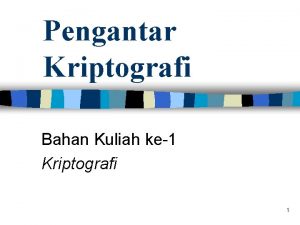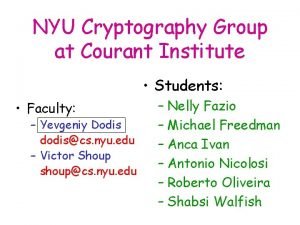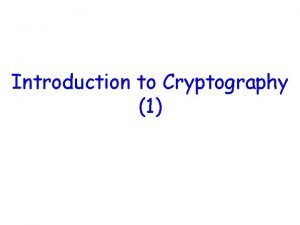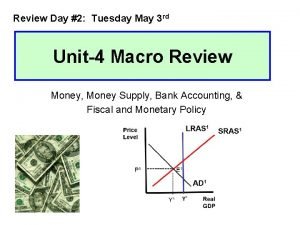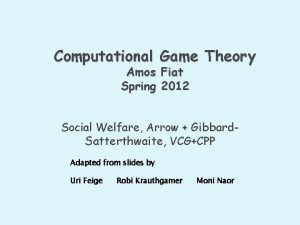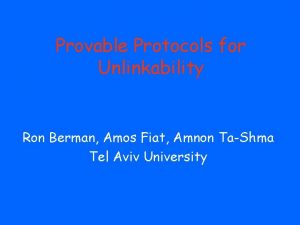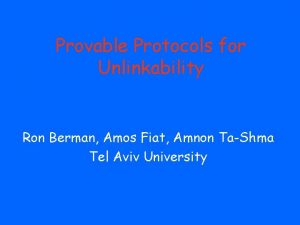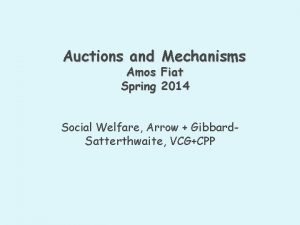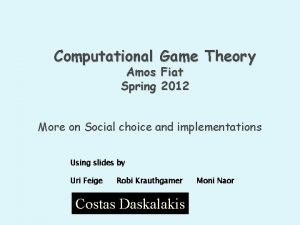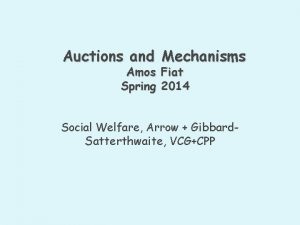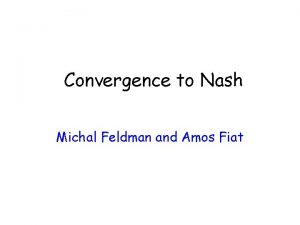Introduction to Modern Cryptography Instructor Amos Fiat Strongly




















- Slides: 20

Introduction to Modern Cryptography Instructor: Amos Fiat Strongly based on presentation and class by Benny Chor School of Computer Science Tel- Aviv Univ.

Administrative Details • • Grade –exam (75% ), homework (25% ). Exam on last class. In class exam. No 2 nd chance. Homework submission in pairs. 2 -3 “dry’’ assignments. 1 -2 “wet” assignments (in MAPLE). Office hours: By e-appointment. E-mail: fiat@cs. tau. ac. il

Course Outline • • • Encryption Data integrity Authentication and identification Digital signatures Number theory Randomness and pseudo-randomness Cryptographic protocols Real world security systems Watermarking, digital rights management, etc.

Prerequisites: Linear Algebra Probability Computational Models “Mathematical Maturity”

Bibliography Text Book: • Cryptography Theory and Practice, D. Stinson, CRC Press, 1996. (should be available at the library) Recommended: • - Handbook of Applied Cryptography Menezes, Van Oorschot, Vanstone (free download at http: //www. cacr. math. uwaterloo. ca/hac ) - Applied Cryptography, B. Schneier

Good Crypto Courses on the Web • • • Hugo Krawczyk course at the Technion. Ron Rivest course at MIT. Dan Boneh course at Stanford. Phil Rogaway Course at UC Davis. Eli Biham course at the Technion. Doug Stinson course at Waterloo.

Encryption Much of Security has little to do with Encryption deals with secrecy Most real security deals with problems of fraud: • Message modifications • Almost invariably, Encryption does not live alone without some form of authentication

Definitions • • • Encryption function (& algorithm): E Decryption function (& algorithm): D Encryption key k 1 Decryption key k 2 Message space (usually binary strings) For every message m: D k 2(E k 1 (m)) = m

Communication Model Alice 1. 2. 3. 4. Bob Two parties – Alice and Bob Reliable communication line Shared encryption scheme: E, D, k 1, k 2 Goal: send a message m confidentially

Threat Model Alice Bob Eve 4. Goal: send a message m confidentially

Security Goals Possibilities: • No adversary can determine m • No adversary can determine any information about m • No adversary can determine any meaningful information about m.

Adversarial model • • • Eve attempts to discover information about m Eve knows the algorithms E, D Eve knows the message space Eve has at least partial information about Ek 1(m) Eve does not know k 1, k 2

Examples – bad ciphers • • Shift cipher Conclusion – large key space required Substitution cipher Large key space, still “easy” to break

Substitution cipher Example: plaintext: ciphertext: attack at dawn • waaoq wa vwmk • Size of key space: 26!=403291461126605635584000000 ~4 x 1028 large enough

Additional definitions • Plaintext – the message prior to encryption (“attack at dawn”, “sell MSFT at 57. 5”) • Ciphertext – the message after encryption (“ ”יחלעכ חעכןטאככעכ , “jhhfoghjklvhgbljhg” ) • Symmetric key – encryption scheme where k 1=k 2 (classical cryptography)

Perfect Cipher • Plaintext space – {0, 1}n • Given a ciphertext C the probability that Dk 2(C)=P for any plaintext P is equal to the apriori probability that P is the plaintext. In other words: Pr[plaintext=P|C] = Pr[plaintext=P] • Probabilities are over the key space and the plaintext space.

Example – One Time Pad • Plaintext space - {0, 1}n • Key space - {0, 1}n • The scheme is symmetric, key k is chosen at random • Ek(P) = C = P K • Dk(C) = C K = P

Pros and Cons • Claim: the one time pad is a perfect cipher. • Problem: size of key space. • Theorem (Shannon): A cipher cannot be perfect if its key space is less than the size of its message space. • Why? ? ? Argue in class.

Computational Power • • • Time Hardware Storage Theoretical – polynomial time Practical – 264 is feasible, 280 is infeasible

Attack Models • • Eavesdropping Known plaintext Chosen ciphertext Adaptive chosen text attacks Physical access “Physical” modification of messages
 Amos fiat
Amos fiat Modern block cipher in cryptography
Modern block cipher in cryptography Introduction to cryptography and network security
Introduction to cryptography and network security Intro to cryptography
Intro to cryptography Nyu cryptography
Nyu cryptography Introduction to cryptography and network security
Introduction to cryptography and network security What is cryptography
What is cryptography Introduction to cryptography and network security
Introduction to cryptography and network security Fiat prayer
Fiat prayer Fiat p0520-67
Fiat p0520-67 Novi fiat 500l pop
Novi fiat 500l pop Linkentry fca
Linkentry fca Fiat delft
Fiat delft Fiat doblo dpf regeneration procedure
Fiat doblo dpf regeneration procedure Sformuowanie
Sformuowanie What's fiat money
What's fiat money What is fiat money
What is fiat money Fiat system
Fiat system Fiat money definition
Fiat money definition Vegetable classifications
Vegetable classifications Types of programming languages
Types of programming languages



